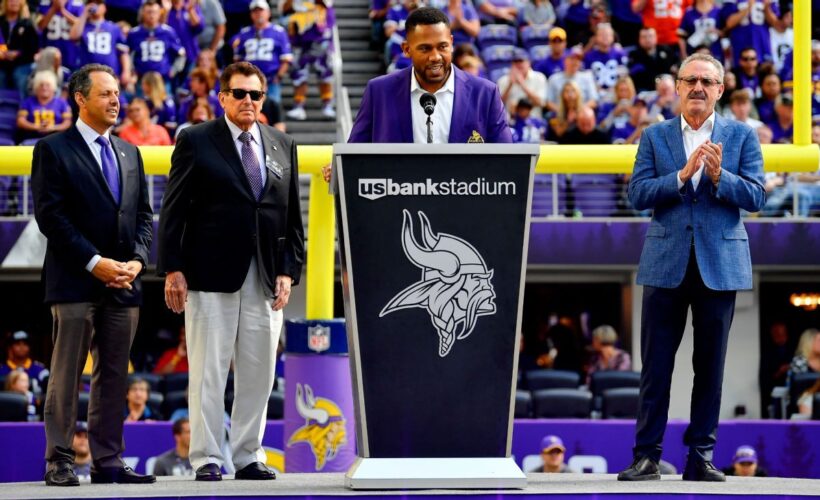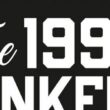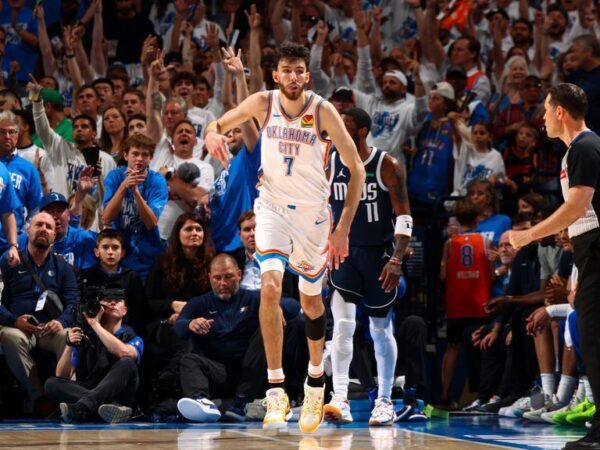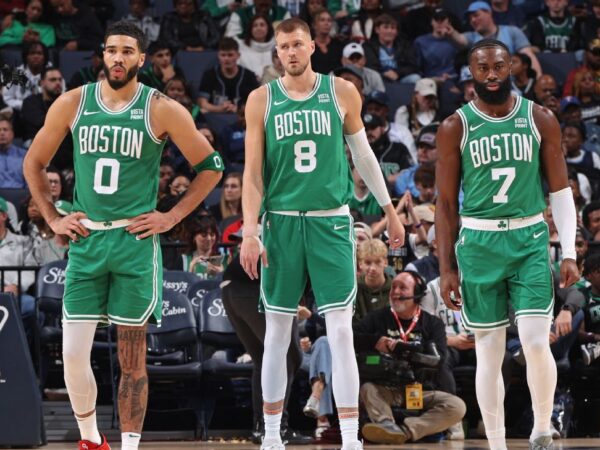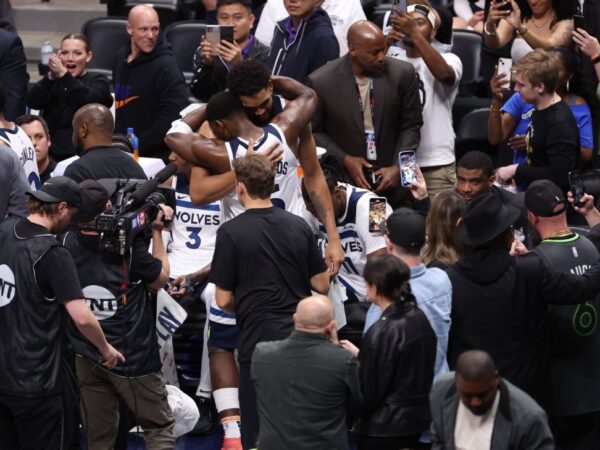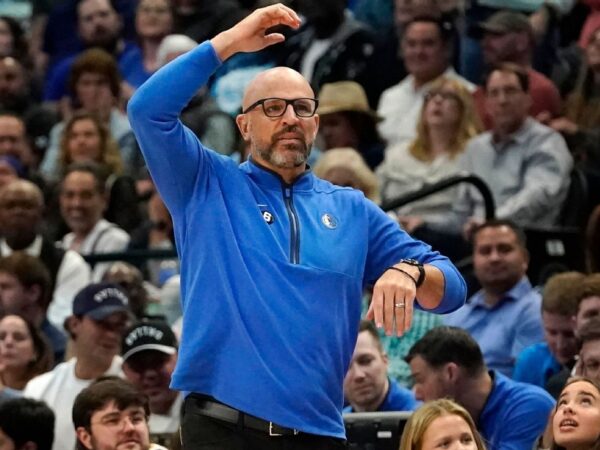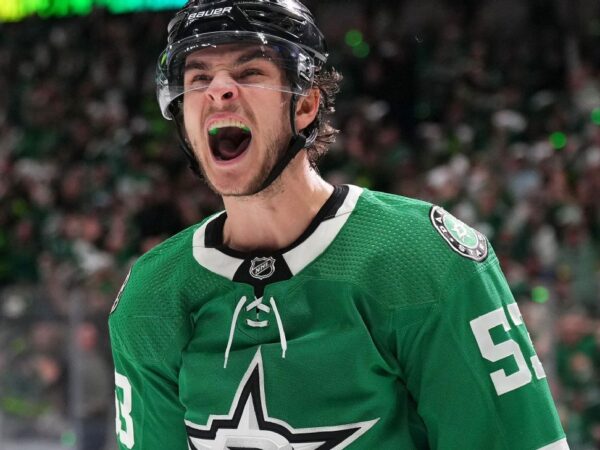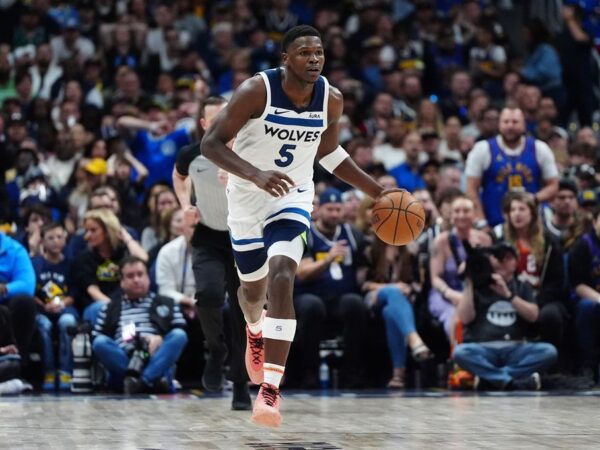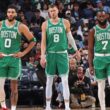FOR THE BRIEFEST of moments, the Minnesota Vikings‘ 2003 draft room swelled with relief. A frenzied effort to trade their No. 7 pick had seemingly concluded with a last-minute deal. Rob Brzezinski, Minnesota’s vice president of football operations at the time, had reported the terms to the NFL’s draft table in New York with 32 seconds remaining in their 15-minute time allotment. The Vikings would swap picks with the Baltimore Ravens at No. 10 in exchange for the Ravens’ fourth- and sixth-round draft selections.
Brzezinski, coach Mike Tice and the rest of leadership sat back to watch the Ravens make their selection, all the while hoping their own target — Oklahoma State defensive tackle Kevin Williams — remained on the board through No. 10. Within seconds, they noticed something strange: The team logo on the ESPN broadcast hadn’t changed.
“We had called in the trade, and we thought it was done,” Brzezinski said. “We’re all sitting there in the draft room, just watching on TV, and all hell broke loose.”
It became one of the wildest scenes in modern NFL draft history. The league never executed the trade — for reasons the league never fully explained — and the Vikings’ time expired.
In the ensuing confusion, the Jacksonville Jaguars and Carolina Panthers jumped ahead to make selections before the Vikings regrouped and drafted Williams at No. 9.
The gaffe subjected the Vikings to national embarrassment in real time. ESPN anchor Chris Berman buried his face in his hands on the live broadcast, and former coach Dennis Green, part of the broadcast team, ridiculed them. A draft party crowd back in Eden Prairie, Minnesota, of nearly 5,000 fans booed Tice when he arrived to address them. In the subsequent months, the NFL quietly worked to implement a series of protocol changes to ensure it could never happen again.
As funny as it might have been to the public, the episode cut deeply on the people involved. Twenty years later, they can reveal a fuller story of how the misstep unfolded and why. It involves millions of dollars, an unanswered phone and a senior citizen hurling profanities at a 6-foot-8 head coach.
Then-owner Red McCombs blamed the Vikings’ front office for a disorganized draft process. But in separate interviews this spring, Brzezinski and Tice disclosed a crucial fact: McCombs had demanded a trade down before the draft started, adding a unique level of pressure to the circumstances. Brzezinski, currently the Vikings’ executive vice president of football operations, declined to speculate on why. Tice, who retired from coaching in 2018, said the reason was apparent to anyone who understood the team’s cash-strapped position at the time.
“We were left to assume the obvious,” Tice said, “which was the difference in the contract at [a lower spot in the draft].”
McCombs died in February at age 95. Tice said he did not want to speak ill of the former owner, and Brzezinski emphasized “this is not to absolve ourselves from responsibility, make excuses or blame others.” But it’s clear that without the mandate, the Vikings would have selected Williams at No. 7 rather than keep pushing for a weak trade with a partner that was lukewarm at best. Williams’ signing bonus alone was about $3 million less at No. 9 than it would have been at No. 7, based on the NFL’s rookie pay scale at the time.
“Ultimately, Red got what he wanted,” a Vikings employee from that era said. “He got Kevin Williams at a cheaper price — but we all got embarrassed.”
ONE OF THE most common misconceptions of NFL draft lore is that the Vikings missed their pick two years in a row. In fact, it was the Dallas Cowboys whose time expired in 2002 at No. 6. The Vikings’ mistake that year was not being quick enough to jump ahead of the Cowboys in line from their spot at No. 7.
That year, Tice had acknowledged publicly that the Vikings wanted to draft North Carolina defensive lineman Ryan Sims. The Kansas City Chiefs also coveted Sims and were completing a trade with the Cowboys to get Sims at No. 6 when time expired.
In those days, the NFL held its drafts in New York City, at Madison Square Garden or Radio City Music Hall. Teams selected players by instructing an on-site representative to write the name on a card and deliver it to an NFL official near the stage. Upon realizing the Cowboys’ time had expired, the Vikings tried to get their card to the stage first, but the Chiefs’ representative beat him to the stage, according to then-Chiefs president Carl Peterson.
The Vikings drafted Miami left tackle Bryant McKinnie instead. After the draft, McCombs reorganized the team’s front office, putting Brzezinski and director of college scouting Scott Studwell in charge of the draft, ahead of vice president of player personnel Frank Gilliam, with Tice maintaining a significant voice.
In 2003, the Vikings were determined to keep their draft plans a secret. After Williams’ dominant performance in the Senior Bowl, the Vikings’ leadership team — Brzezinski, Tice and Studwell — agreed he would be their top target at No. 7. Then they went to great lengths to minimize their chances of a repeat of 2002.
“I didn’t talk to the Vikings one bit,” Williams said recently from his home in Arkansas. “I was thinking I would get drafted in the top 15, but I didn’t know where.”
If all went well, the Vikings’ stealth plan would net them a prospect they coveted more than any other. Then, on the morning of the first round, a knock came from outside the draft room door.
McCOMBS HAD PURCHASED the Vikings in 1998 for $206 million. Three years into his tenure, he grew frustrated with the limited local revenues he received from playing home games at the Metrodome, which had limited inventories of the kind of club seats and luxury boxes that drive stadium revenue. State government officials had made clear they wouldn’t help replace the stadium until after the team’s lease expired in 2011.
In a 2001 interview with the Star Tribune of Minneapolis, McCombs said he had covered revenue shortfalls for two consecutive seasons and would not continue. Asked whether that decision would impact football budgets, he said: “I think we’re into that mode now. I think it would be obvious that it would.”
Signs of that budget cutting were everywhere by 2002, when McCombs fired Green and replaced him with Tice, the team’s offensive line coach, who agreed to become the lowest-paid coach in the NFL. The payroll for assistant coaches was also the NFL’s lowest, Tice said at the time. McCombs did not hire a general manager after Green departed, and before the end of the year, McCombs instructed his bankers at JP Morgan Chase to solicit purchase offers for the franchise.
That was the backdrop for the 2003 debacle. As Tice remembers it, Vikings president Gary Woods pulled the team’s top officials from the draft room into a hallway to inform them of McCombs’ mandate. No one was surprised.
“We figured that was par for the course,” Tice said. “There might have been some humming a few days before that we were going to get ‘nudged’ to trade the pick, if you will. But I do know that in the morning, right at the time when the draft started, we were told to trade the pick.”
Woods, who remains an officer of McCombs Enterprises in San Antonio, did not return multiple phone calls and emails.
Brzezinski began working the phones but found relatively light interest for the No. 7 spot. ESPN reported at the time that the Vikings spoke with the Jaguars and the New England Patriots, but the Ravens were always the likeliest target, given their presumed interest in drafting Marshall quarterback Byron Leftwich, who was considered the second-best quarterback in the draft after USC’s Carson Palmer. Brzezinski kept pushing, but the Ravens’ best offer — fourth- and sixth-rounders — was a significant loss on the Jimmy Johnson trade value chart, a popular tool at the time.
The price for risking the loss of a coveted player should have been much higher. Ultimately, though, the Vikings had no choice. They reported the deal by phone to Joel Bussert, the NFL’s vice president of player personnel, and assumed the Ravens were doing the same.
They never did. According to the Ravens, their call to Bussert went unanswered.
“The deal was not consummated,” general manager Ozzie Newsome said at the time. “A deal is not a deal until I talk to Joel Bussert, and I never talked to Joel Bussert.”
Newsome repeated that explanation to Brzezinski during a subsequent phone call.
0:54
Flashback: Vikings’ delay shakes up 1st round of 2003 draft
During the 2003 NFL draft, the Vikings initially missed their chance to draft in the first round, allowing the Jaguars and Panthers to make selections before Minnesota made one.
“Ozzie said he couldn’t get through,” Brzezinski said. Newsome, who stepped down as GM in 2018 but is now the Ravens’ executive vice president, declined to comment.
Asked whether he believed the Ravens’ account, Tice said: “Probably not 100% in belief of it. But it is what it is. It’s what we were told, and how are you going to say that’s B.S.? We just moved on.”
Bussert, who retired in 2015, declined to comment through an NFL spokesperson.
“It had never happened in history,” Brzezinski said, “but it could have been a malfunction with the league in their process.”
In the ensuing moments, however, the Jaguars (No. 8) and Panthers (No. 9) sprang into action.
One of the jobs of the onsite team representative was to watch the official draft clock, which is not visible to teams in their draft rooms. Jaguars video director Mike Perkins was in New York and began alerting team officials when the Vikings’ time allotment was down to 20 seconds.
“Minnesota’s table was right to my left, like 5 feet from me,” said Perkins, now the Jaguars’ senior director of football technology. “And I’m looking at them and they don’t have a card filled out.”
Perkins urged his superiors in Jacksonville to give him a name he could submit if the Vikings’ time expired.
“[They said], ‘OK, fill this card out: Byron Leftwich,'” he said.
Jackie Miles, then the Panthers’ equipment manager, had been watching both the clock and Bussert from his perch in New York.
“When it got down to about two minutes,” Miles said, “I’m telling our people back in the war room. They asked if there was any activity at the [NFL] table. I’m watching the trade phone. … They weren’t picking up the phone. Minnesota wasn’t doing anything at their table. There was no activity. I said, ‘Guys, get something ready for me.'”
Seconds after the Jaguars drafted Leftwich, the Panthers turned in their card for Utah offensive tackle Jordan Gross. In the meantime, the Vikings had urgently instructed Leo Lewis, their director of player development, to rush a card with Williams’ name on it. They got Williams at No. 9, just before the Ravens selected Arizona State linebacker Terrell Suggs.
Williams was unaware of the sequence of events. He was attending a cookout in Arkansas, waiting for his phone to ring, when his brother’s girlfriend noticed his name on the broadcast. That was the first sign of trouble.
“Usually they call you before the pick is announced to let you know,” Williams said. “I found out later that it had been a debacle, but honestly, I never even cared to ask Tice or Studwell or anyone about it. It never mattered to me. If I was drafted ninth overall or No. 7 or whatever you want to call it, I wanted to do my job. I thought I was good enough. I wanted to show it and be all I could be for the Minnesota Vikings.”
When it was over, the Vikings’ draft room burst into celebration, Tice said.
“Our biggest fear was that somehow we would lose Kevin Williams,” Tice said. “He was our guy. We were in celebratory mood when we got Kevin. Believe me.”
And then, Tice emerged from the draft room. He walked to the team’s indoor facility to address what he assumed would be a friendly crowd, one that would share in the celebration.
He was wrong.
THE PARTY WAS hosted by two members of the Vikings’ radio team at the time, play-by-play announcer Paul Allen and analyst Mike Morris. Unaware of the Vikings’ interest in Williams, Allen had been leading the crowd in cheers for Suggs during the hours leading up to the Vikings’ pick.
“I think partially because of the Suggs stuff we got going,” Allen said, “and also because of the fact that people were confused and some were inebriated and had no idea what happened, they just booed the whole situation vociferously. Then Mike Tice came out and he was going to be interviewed by me and [Morris.]”
As Tice arrived, his 6-foot-8 frame decked out in a pinstriped suit, a woman approached him on the stage.
“She was standing right there MF-ing me, man,” Tice said. “I’m getting heckled and yelled at by Granny Smith.”
Addressing her and trying to be heard over the din, Tice said, “OK, OK. Calm down.” KFAN-100.3 FM, the Vikings’ flagship station, still uses that sound bite as a bit on its daily talk shows.
“I’m getting heckled and yelled at by Granny Smith.”
Vikings coach Mike Tice
“It’s funny — now,” Tice said, but Allen remembers thinking Tice was deeply hurt in the moment.
“I don’t have any confirmation on this,” Allen said, “but in knowing Mike as well as I do and as long as I have, Mike genuinely cared about public opinion. He cared about what the public said, positively and negatively. I’d have to believe the experience he had with those boos and that lady cussing at him probably stuck with him for quite some time.”
Some evidence: For his final two drafts during his tenure as head coach, Tice invited Allen into his office before the draft to share details of the team’s draft board.
“He would say, ‘So we don’t have any Suggs chants, here’s how our board lays out in the first 20, and don’t tell anybody,” Allen said. “So there was serendipity for me. We knew who the Vikings wanted to pick, and it helped us shape the environment [during draft parties].”
It was also a fortunate moment for the Vikings. Although the missed pick never bothered Williams, he found the Suggs chants insulting.
“That kind of stuck with me,” Williams said. “It was one of those, ‘I’ll show you’ type of deals. I found motivation in it. I was out to prove I was one of the best players in the draft anyway, and it only added more self-motivation.”
SUGGS WENT ON to a likely Hall of Fame career, recording 139 sacks in 16 seasons. But Williams joined him on a short list of the best players of the 2003 draft. He recorded 10.5 sacks as a rookie, earned All-Pro honors five times, was named to six Pro Bowl teams and was inducted into the Vikings’ Ring of Honor in 2021.
“I think at the end of the day, Minnesota still got the better end of the stick, in my opinion,” Williams said. “If I turned out to be an inadequate player, I think everybody would still be talking about it.”
Said Tice: “I bet you no one is heckling that pick now.”
The Vikings also took solace in the fact that both Williams and McKinnie, their fallback pick in 2002, were starters on the 2009 team that played in the NFC Championship Game. And despite the first-round fiasco, the 2003 draft class was probably the Vikings’ best of the decade. All seven players appeared in games as rookies. Second-round pick E.J. Henderson started 105 games over nine seasons at middle linebacker. Third-round receiver Nate Burleson produced a 1,000-yard season in 2004 and went on to an 11-year career.
The Vikings sought but never received a comprehensive response from the NFL about the phone line, Brzezinski said. But Bussert confirmed through an NFL spokesperson that, beginning in 2004, the league added multiple phones and additional staffing to its football operations table at the draft, changes that seemed to address the Ravens’ explanation. These days, teams submit their choices electronically through league software.
Can a fuller set of facts alter the controversy’s template?
“It was embarrassing, but I think what’s most important is that we got the guy that we wanted,” Brzezinski said. “I’m really proud of our scouts and coaches for identifying Kevin. He’s in our Ring of Honor and is potentially a Hall of Fame player. We ended up achieving the goal that we wanted to achieve. But could we have done it without the embarrassment and the circus? Of course.”
ESPN’s Michael DiRocco and David Newton contributed to this report.
Source:ESPN

